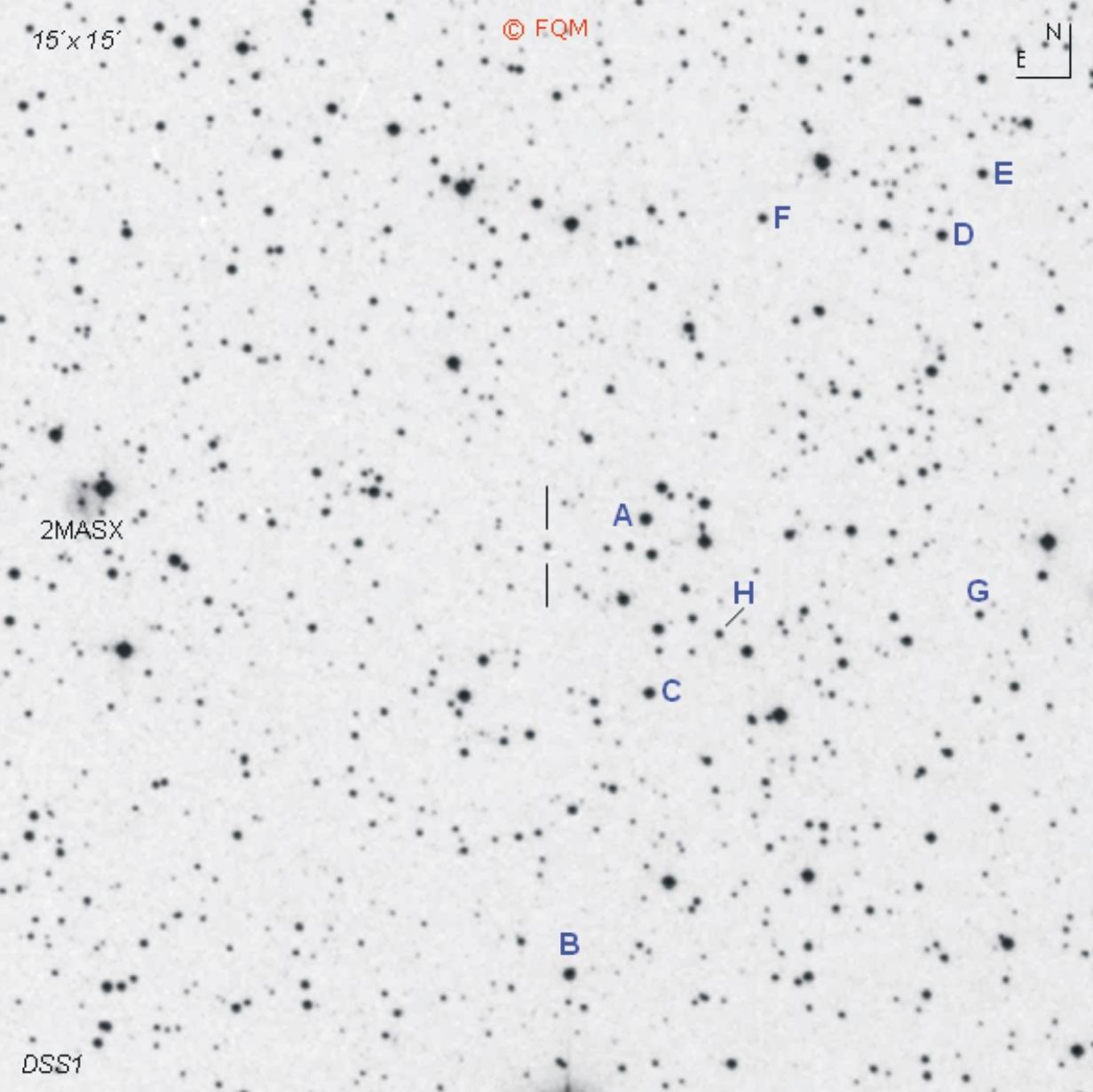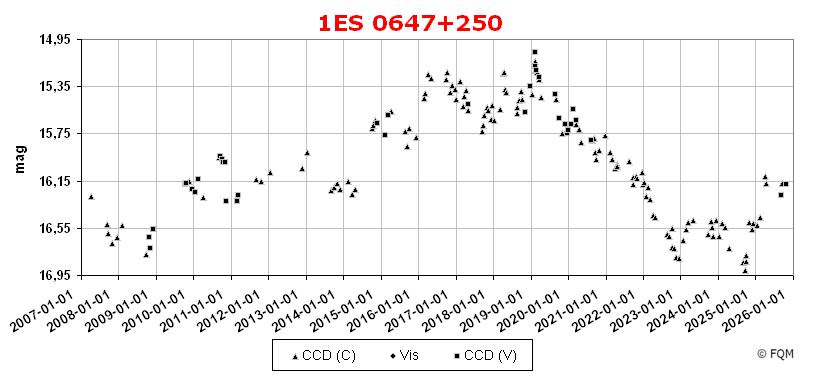
| Frankfurt Quasar Monitoring |
| 1ES 0647+250 |
| Cross-Identifications | QSO B0647+250, MG2 J065043+2503, 0647+250 2MASS J06504649+2502596, RX J0650.7+2502 2XMM J065046.5+250259, 1FGL J0650.7+250 1RXS J065046.7+250257, GB6 J0650+2503 87GB 064743.0+250645, RGB J0650+250 |
| Equat. coordinates | RA 06 50 46.5 DE +25 03 00 (J2000) |
| Constellation | Gemini |
| Type | BL Lac |
| Redshift (2) | z=0.203 |
| Distance (2) (3) |
799 Mpc |
| Total mag range (mv) (5) (4) | 15.06 - 16.84 |
| Catalog Magnitude | 15.3 (1) / 15.7 (2) |
| Absolute Magnitude (1) | --- |
| Light Travel-Time (2) | 2.377 × 109 yrs |

Comparison stars
| star | B | V | Rc | Ic |
| A | 13.593 (0.015) | 13.089 (0.008) | 12.768 (0.013) | 12.459 (0.016) |
| B | 14.125 (0.021) | 13.446 (0.015) | 13.057 (0.017) | 12.699 (0.021) |
| C | 14.405 (0.028) | 13.782 (0.023) | 13.394 (0.028) | 13.033 (0.031) |
| D | 14.870 (0.025) | 14.094 (0.013) | 13.651 (0.022) | 13.264 (0.024) |
| E | 15.648 (0.018) | 14.725 (0.011) | 14.190 (0.019) | 13.703 (0.023) |
| F | 15.892 (0.038) | 15.073 (0.028) | 14.580 (0.036) | 14.089 (0.039) |
| G | 16.085 (0.044) | 15.477 (0.026) | 15.111 (0.057) | 14.743 (0.062) |
| H | 16.695 (0.051) | 15.878 (0.026) | 15.399 (0.060) | 14.929 (0.069) |

| 1ES
0647+250 is a violently variable BL Lac object in Gemini. Its position
lies about 1.5° E of 3-mag star Epsilon (27) Gem. 1ES 0647+250 was
discovered as a radio source in 1987 during the Second MIT-Green Bank 5
GHz Survey (MG2), which was carried out with the 91-m NRAO radio
telescope in
Green Bank, West Virginia. The designation 1ES 0647+250 refers to the
Einstein Slew Survey, where this object was detected as an X-ray
source in the early 1990s. The radio and X-ray position of the new
source were matched with a stellar optical counterpart of about
mag 15.3 on POSS
blue plates. In 1991, spectral analysis revealed a
featureless continuum, which led to the classification as a BL
Lacertae type object. The new blazar was found to be violently variable from radio to X-ray wavelengths. Besides the radio and X-ray, 1ES 0647+250 has been detected also as a source of infrared, ultra-violet and even gamma emissions. The redshift of z=0.203, as given above, is not based on direct spectroscopy but results from the BL Lac luminosity, which is hosted by a typical elliptical galaxy. Other investigations conclude a larger redshift of z=0.41 (Kotilainen 2011). New spectroscopic investigations with large 8-m/10-m class telescopes are needed to fix the true distance of this blazar. Blazar 1ES 0647+250 is a violently variable object with a total optical range of about 1.8 magnitudes. According to the literature, the brightness level varies between 15.24 mag and 16.84 mag in the optical, so visual observers need large aperture telescopes to glimpse this stellar object. During an optical flare state in 2-2019 a new all-time maximum of 15.06mv in the optical was observed during the Frankfurt Quasar Monitoring programme. Both CCD observers and visual observers shall use the comparison stars given above. Another photometric sequence was published by Nilsson et al. (2007). The finding chart above also shows a circular object, 8.4 arcmin E of the blazar. At first glance its photographic appearance resembles that of a planetary nebula. But in fact, this is a faint face-on disk galaxy with the designation 2MASX J06511477+2503237, denoted as 2MASX (Data from NASA/IPAC Extragalactic database). ____________
The
position of blazar 1ES 0647+250 lies about 1.5° E of 3-mag star Epsilon
(27) Gem. At a distance of at least 800 Mpc, this blazar is located far behind
the eastern outskirts of the Milky Way in Gemini. Therefore, observers
find some galactic deep sky showpieces around the blazar: Open clusters M 35 and NGC 2158 lie some 10° W, supernova remnant IC 443 is situated about 8° WSW, and finally sweep your scope 10° to the ESE from the blazar position to meet planetary NGC 2392, the famous "Eskimo-Nebula". Far beyond our Milky Way, two other blazars, both located in Cancer, may attract the observers interest: OJ 287 (29° east), and PKS 0754+100 (22° to the south-east). Both extragalactic variables lie at a distance of about 3×109 light-years. |
| Elvis, M., et al. 1992, ApJS 80, 257; The Einstein Slew Survey. Falomo, R., Kotilainen, J.K., 1999, A&A 352, 85; Optical imaging of the host galaxies of X-ray selected BL Lacertae objects. Kapanadze, B.Z. 2009, MNRAS, 398, 832; Optical R-band variability of seven X-ray-selected BL Lacertae objects. Kotilainen, J.K., et al. 2011, A&A 534, L2; The host galaxy of the BL Lacertae object 1ES 0647+250 and its imaging redshift. Langston, G.I., et al. 1990, ApJS 72, 621; The Second MIT-Green Bank 5 GHz Survey. Linford, J.D., et al. 2012, ApJ 744, 177; Contemporaneous VLBA 5 GHz Observations of Large Area Telescope Detected Blazars. Nilsson, K., et al. 2007, A&A 475, 199; Host galaxy subtraction of TeV candidate BL Lacertae objects. Sbarufatti, B., Treves, A., Falomo, R. 2005, ApJ 635, 173; Imaging Redshifts of BL Lacertae Objects. Schachter, J.F., et al. 1993; Ten new BL Lacertae Objects discovered by an efficient X-ray/Radio/Optical Technique. Urry, C.M., Scarpa, R., et al. 2000, ApJ 532, 816; The Hubble Space Telescope Survey of BL Lacertae Objects. II. Host Galaxies. Véron-Cetty, M.-P., Véron, P. 2001, A&A 374, 92; A Catalogue of Quasars and Active Nuclei: 10th edition. Véron-Cetty, M.-P., Véron, P. 2003, A&A 412, 399; A Catalogue of Quasars and Active Nuclei: 11th edition. Véron-Cetty, M.-P., Véron, P. 2006, A&A 455, 776; A Catalogue of Quasars and Active Nuclei: 12th edition. Véron-Cetty, M.-P., Véron, P. 2010, A&A 518, 10; A Catalogue of Quasars and Active Nuclei: 13th edition. |
| Links: Landessternwarte Heidelberg ATel #6726: Optical flare of the TeV blazar 1ES 0647+250 AAVSO |
| home |